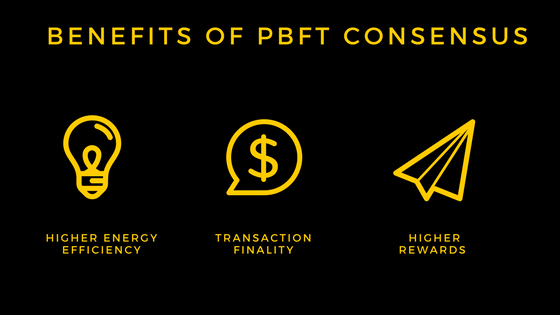5 Applications of Blockchain in Business and Economy
The blockchain is a digital ledger of transactions that records all the exchanges of cryptocurrencies in a decentralized manner. Blockchain allows...
5 min read
Preetisha Dayal : Apr 19, 2018 12:00:00 AM

A Blockchain is a decentralized shared network with no focal authority figure. Though this makes a framework that is without debasement from an individual source, despite everything it gives rise to noteworthy issues.

How are any decisions made? How can anything complete?
For cryptocurrency exchanges to be led effectively, they should be affirmed by the blockchain. These affirmations depend on what is alluded to as consensus mechanisms. It empowers the system to continue working regardless of whether some of its members are coming up short.
In this article, we present the primary Blockchain consensus mechanisms utilized by driving cryptocurrencies and tokens.
Proof of Work (PoW) is particularly for cryptocurrencies, and the most utilized system of all. This is presumably the case because since 2009 it has officially demonstrated its strength and security.
Mining is the central part of the majority of the modern digital forms of money and prominent Blockchain applications. Additionally, for the Ethereum, a transaction must be bundled into blocks with a specific goal to be declared as a major aspect of the history. Thus, it has been named as Proof of Work.
Basically, it portrays the conditions that members of the system must demonstrate how many functions they have spent so as to have the capacity to confirm transactions. In this way, they get compensated for each block that they approve and confirm. The surplus on the compensating sums is a benefit for the miners and serves as an incentive. Altogether, the reward for a block comprises of the general block remuneration and the total of all expenses from all exchanges contained in the block.
Moreover, the high monetary contribution of miners guarantees that the produced coins are really upheld by genuine incentive in respect of fiat money. Thus, mining is the flow of fiat cash into coins of a digital currency.
Did Blockchain got you excited? Then grab your free copy right here.
Like in a business entity, shareholders have a privilege of partaking in this consensus mechanism thus, it is known as Proof of Stake (PoS).
With Bitcoin's high cost of mining, blockchain drivers looked for less expensive options that didn't require consuming high measures of energy. The energy utilization is constrained to the use and approval actions of users and isn't misleadingly expanded by superfluous complicated calculations. The first of these choices is PoS, which allows the level of duty in keeping up general community ledger to a node as indicated by the number of coins it handles. The more coins a node carries, the more possibilities it has of being chosen to refresh the ledger.
As POS needs neither particular hardware nor the burning of energy, it is one of the least expensive blockchain consensus conventions. It is additionally amongst the most comprehensive since all the coin holders in a system have an opportunity to take an interest in the mining procedure.
 Now we approach an intriguing type of Proof of Stake called Delegated Proof of Stake (or DPOS) presented by University of Michigan researchers Eric Wustrow and Benjamin Vander Sloot. EOS is utilizing this mechanism to scale up to a large number of exchanges every second.
Now we approach an intriguing type of Proof of Stake called Delegated Proof of Stake (or DPOS) presented by University of Michigan researchers Eric Wustrow and Benjamin Vander Sloot. EOS is utilizing this mechanism to scale up to a large number of exchanges every second.
Initially, any individual who holds tokens on a Blockchain coordinated in the EOS programming can choose the block makers through a constant approval voting network. Anybody can partake in the block generator election and they will be provided a chance to create blocks proportionate to the aggregate votes they get with respect to every single other generator.
In the event that they can really pull it off, at that point they will have the DPoS to thank.
Value of one digital currency can be exchanged then onto the next through the Proof of Burn (PoB) mechanism. This implies a node takes part in a lottery to choose the status of the blockchain by burning value they as of now hold, as another cryptographic money, for example, bitcoin or ether.
To locate the following block, the node transfers bitcoin, ether or some other digital currency to an unspent address. In return, the node gets a reward in the coins local to the Blockchain it supports to sustain.
The principal Blockchain to effectively apply the PoB mechanism for mining was Slimcoin. Its system consolidates Proof of Burn with PoW and PoS, making it the first cryptocurrency to join three consensus mechanisms.
Distributed networks could use Practical Byzantine fault-tolerant (PBFT) mechanism. Every node distributes a public key. Messages getting through the node is designated by the node to confirm its organization. When enough indistinguishable reactions are achieved, at that point a consensus is met that the message is a legitimate transaction.
PBFT is a network formed for the low-latency storage framework. This is pertinent to digital resource-based platforms that don't need a lot of through puts yet ask numerous transactions.

Besides, trust is completely decoupled from asset possession, which makes it feasible for a non-profit to keep capable small organizations legit.
Not at all like PoW and PoS, a PBFT consensus mechanism does not require any hashing energy to approve exchanges in a blockchain, which implies there is no requirement for high energy utilization and the danger of centralization is lower than in both of those blockchain mechanisms.
PBFT is presently being utilized by the Hyperledger venture, which enables developers to fabricate their own particular digital resources on a disseminated ledger.
Proof of Identity (PoI) is a cryptographic evidence (piece of data) which tells that any user knows a private key that compares to an authorized identity and cryptographically attached to a specific transaction. Every individual from some group can create a PoF (only a block of data) and present it to anyone for instance to the processing node.
Proof of Elapsed Time (PoET) endeavors to direct the issue of PoS which arbitrary determination of members proposing blocks is expected to guarantee that each member has a reasonable opportunity to offer a block and, in this manner, produce prevalent advantages.
In this, every member asks for a hold-up time from its local reliable enclave. The member with the briefest hold-up time is next to offer a block after it hold-up for the allotted waiting time. Each privately trusted enclave signs the potential and the result so other members can confirm that none has deceived the waiting time.
All things considered, it has been asserted by the people broadcasting PoET that it serves the qualities of PoS.
The last variation from the consensus mechanisms that we will discuss is the Proof of Importance (PoI). The primary cryptographic money platform to execute this was NEM. With PoI, it isn't just the coin balance that values.
NEM's consensus network depends not only the number of coins but on the possibility that productive system action ought to be remunerated. The chances of staking a block are a component of various factors, including notoriety (controlled by a different purpose-designed framework), balance, and the number of transactions made to and from that position. This gives a more all-encompassing image of a 'helpful' system member.
These are chosen utilizing a specific algorithm, not just by probability and size of their shares. Likewise, their significance for the system and the significance that the system clearly has for them stream into the procedure. A recognition of fake use and manipulative models is, obviously, included in this idea to avoid spammy members to pick up a higher importance score.
Furthermore, just a particular sort of stake is considered for the mechanism to be considered as possessions. Coins in the NEM wallet are not considered as wealth until the point that they are vested. 10% of the un-vested coins for every 24 hours will be charged to this vested wallet. Accordingly, members get an incentive to make just vital transactions and can just increment the importance score gradually by demonstrating their association with the system.
Blockchain networks that utilize PoS incorporate Nem, Dash, and Peercoin. Likewise Ethereum is thinking to move its protocol from PoW to PoS when it embraces its Casper network.
There are numerous variations of consensus mechanism methodologies. In all cases, the objective of the consensus approach is to ensure the system, predominantly through financial means: it ought to be excessively costly, making it impossible to attack the system, and more profitable to keep it secured. Choice of the required consensus mechanism process ought to be made reliant on the project prerequisites.
Have a project in head? Then reach out to us for a free consultation.

The blockchain is a digital ledger of transactions that records all the exchanges of cryptocurrencies in a decentralized manner. Blockchain allows...

Social media has become a part of our daily life. For instance, 68% of U.S. adults (you know, your customers) use Facebook. This brings a lot of data...

The Blockchain is a distributed ledger that keeps the record of the ever-growing list of transactions, which are decentralized and impossible to...